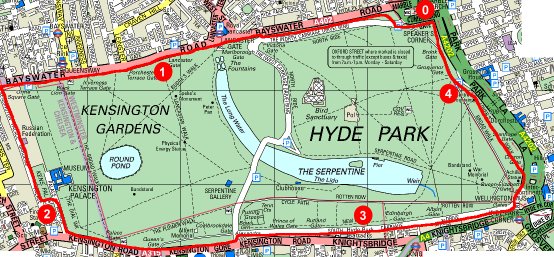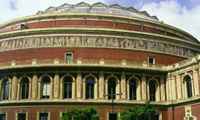Serpentine Running Club

Sights and history
Hyde Park was enclosed by Henry VIII in 1536 to be used as a deer chase. In 1637, it was opened as a public park, and the crowds came to watch horse-racing and other sports. Deer were still hunted here during the 18th century, and finally disappeared in about 1840. The Great Exhibition took place here in 1851, between Rotten Row and Knightsbridge, and the profit was used to establish the museums in South Kensington.
Hyde Park has an area of 361 acres, and Kensington Gardens around 274 acres.
Marble Arch was designed by John Nash in 1827. Made of white Italian marble, it was intended to stand in front of Buckingham Palace to celebrate the end of the Napoleonic Wars. But the arch was too narrow for the Gold Stage Coach, and in 1837, the arch was dismantled and moved to its present position, which is the site of the Tyburn gallows.
Speakers' Corner was established in 1872. Contrary to the urban legend, there is no particular right of free speech at Speakers' Corner: there is, however, a right of assembly.
At Victoria Gate, where you cross the road leading out of the park, is the famous pet cemetery established in 1880. The gravestones can be seen from the Bayswater Road.
Across the road is Kensington Gardens. These were once the private gardens of Kensington Palace. Their design is due to Queen Caroline, wife of George II.
Kensington Palace Gardens – often known as "millionaires' row" – is guarded at either end. This private avenue is almost exclusively for embassies and ambassadorial residences. The original houses were planned in 1843 when the palace kitchen gardens were sold for development. At the top, on the left, is the remarkable modern building which used to be the Czechoslovakia Embassy. Further down, No.8 was the primary interrogation centre for German prisoners during the Battle of Britain.
Kensington Palace was built in 1605, and bought in 1689 by William III (of whom there is a statue behind the front gates). From then until the death of George II in 1760 it was a residence of the reigning sovereign. The old house was altered and extended by Sir Christopher Wren. In recent years it has been used as a high class apartment block for the minor royals, most notably Princess Diana.
The Albert Memorial (1864-1872) is a mid-Victorian monument to Albert, consort of Queen Victoria. Designed by Sir Gilbert Scott, the centrepiece is a 14ft statue of the Prince Consort made of gun metal, surrounded by statues.
 The Royal Albert Hall was build in 1867-1871. The round hall was designed by Captain Fowke, a Royal Engineer. It is almost a quarter of a mile in circumference. The Royal Albert Hall is the site of the annual Proms concerts, including the Last Night of the Proms. The Royal Albert Hall was build in 1867-1871. The round hall was designed by Captain Fowke, a Royal Engineer. It is almost a quarter of a mile in circumference. The Royal Albert Hall is the site of the annual Proms concerts, including the Last Night of the Proms.
At three miles, you pass the Knightsbridge Barracks and stables on your right. These were built in 1970. 270 horses are stabled in the East Wing. In 1984, the IRA planted a bomb which killed several guardsmen and horses, not far from the Cavalry Memorial near the bandstand.
At Edinburgh Gate on the right, admire the Pan sculpture by Jacob Epstein, finished in 1959. This was his last work.
The Triumphal Arch at Hyde Park Corner was built in 1828, designed by Decimus Burton. The Wellington Monument (the statue of Wellington on the back of his favourite horse, Copenhagen) is by Boehm.
When Diana, Princess of Wales died in a car crash in 1997, her funeral procession began at her apartments at Kensington Palace. It passed through Hyde Park, down Constitution Hill, The Mall, Horse Guards, Whitehall then to Westminster Abbey for a funeral service.
In Hyde Park Corner, glance to your right at Apsley House on the other side of the road, the London home of the "Iron" Duke of Wellington, victor at Waterloo and later Prime Minister. This was the site of a pub, and then the old lodge of Hyde Park. The house was built in the 1780s, and bought by Wellington in 1817. In 1947, the 7th Duke of Wellington presented the house to the nation. The museum contains mainly artefacts associated with the Duke of Wellington including his death mask and his and Napoleon's swords from Waterloo.
As you leave Hyde Park on to Park Lane, you pass through the over-ornate Queen Elizabeth Gate, erected in 1993 to celebrate the Queen Mother's 93rd birthday, and paid for by public subscription. The stainless steel and bronze gates were designed by Giuseppe Lund, and the lion and unicorn panels were sculpted by David Wynne.
Then to your left is the Achilles Statue by Richard Westmacott, cast from captured cannon, in honour of the Duke of Wellington. It was the first nude statue in England, and said to have embarrassed the women who presented it to Wellington. Opposite, in the centre of the road, is a bust of the poet Byron and his dog, Bo'sun, by Belt.
As you return to Speakers' Corner, spare a thought for the victims of the Tyburn Gallows, commemorated by a stone in the railings in Bayswater Road. The gallows here were first a tree, then a gibbet and finally an iron triangle for multiple executions. 72,000 people died here during the reign of Henry VIII alone. The condemned were drawn through the streets from the Tower or from Newgate, and then hanged (and often drawn and quartered too) before the huge crowds which gathered to hear the last words, and to enjoy the side shows. Popular victims were toasted in gin or beer as they passed.
Owen Barder
|
No comments:
Post a Comment